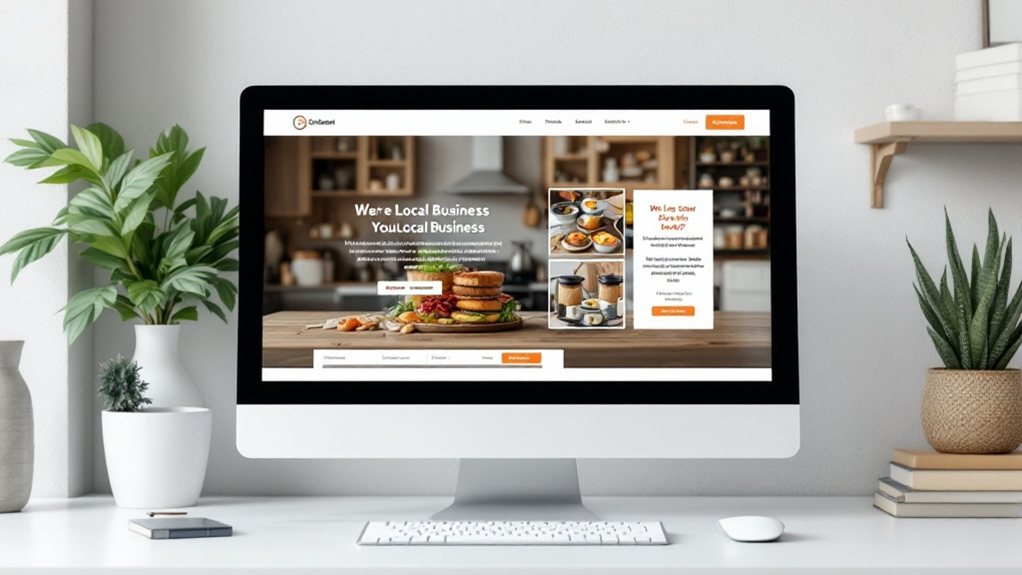As a local business, your homepage should speak directly to your community. Optimize your local keyword targeting, design a conversion-focused layout, and enhance user navigation. Craft compelling calls-to-action and leverage social proof to build trust. Develop hyperlocal content strategies and create dedicated landing pages. Utilize data-driven analytics to continually refine and improve your homepage experience. Keep reading to dive deeper into the strategies that can help you attract and convert more local customers.
Optimizing Local Keyword Targeting

When optimizing local keyword targeting, you'll want to begin by understanding the nuances of local keywords. Local intent refers to the underlying goal of a searcher who wants results relevant to their geographic location. Incorporate quality, occasion, type, and special offering modifiers to refine your targeting. Use city names, neighborhoods, or landmarks to specify your business location. Balance high search volume with achievable competition, and start with basic, generic phrases related to your business. Utilize keyword research tools to expand and analyze your options.
Conduct competitor analysis to identify untapped opportunities. Target long-tail keywords combining location and service terms for lower competition and higher conversion rates. Assess keyword difficulty to prioritize your efforts effectively. Adapt your targeting based on regional trends and events to stay relevant. Track and analyze key metrics to inform your SEO decisions.
Designing the Homepage for Conversion Efficiency

With your local keyword targeting strategy in place, it's time to turn your attention to designing a homepage that effectively converts your target audience. Ensure your page loads quickly, as 47% of users expect 2-second or less load times. Incorporate clear, prominent CTAs to guide users toward taking action, and consider removing navigation to focus attention. Embrace a clutter-free, mobile-responsive design that maintains user focus. Conduct A/B testing to identify the most effective layout and design elements. Having 40 or more landing pages can increase conversion by 500%. By optimizing your homepage for conversion efficiency, you'll nurture local leads and boost your bottom line.
Enhancing User-Centric Navigation

How can you enhance user-centric navigation on your website? Use clear and consistent labels to make it easy for users to understand your content. Streamline your menu structure to reduce clutter and improve intuitive navigation. Ensure your design is responsive, adapting to different devices. Leverage visual cues like icons to guide users through your site. Simple and trustworthy navigation will boost your website's professionalism. Maintain consistent elements across pages, include search functionality, and regularly test and refine based on user feedback. Incorporate navigation patterns like top bars, sidebars, and breadcrumbs to enhance engagement. With user-centric principles and data-driven improvements, you can create an effortless navigation experience for your local customers.
Crafting Compelling Calls-to-Action
| Understanding the Target Audience | Creating Clear and Concise Messages | Incorporating Action-Oriented Words |
|---|---|---|
| Analyze user data | Use specific actions | Leverage strong verbs |
| Recognize pain points | Align with user expectations | Emphasize benefits |
| Adapt based on feedback | Keep messages concise | Incorporate variety |
Crafting CTAs that resonate with the target audience is key for effective homepage design.
Leveraging Social Proof and Trust Signals
Showcasing social proof through genuine testimonials and industry certifications can instantly build trust with your local customers. Social proof is a powerful trust signal that validates claims throughout the website with evidence from actual customers achieving real results. Additionally, highlighting your community involvement and consistent branding across platforms will further reinforce your credibility. Leverage these tactics to create an engaging homepage that drives conversions from your target audience.
Testimonials and Certifications
Testimonials and certifications are powerful tools for building trust and credibility with your local customers. 72% of customers trust a business more after reading positive reviews, and 92% of buyers read testimonials before making a purchase. Strategically placing authentic testimonials near CTAs and on your homepage can increase conversions by up to 34%. Displaying industry-specific certifications alongside testimonials further enhances your credibility, as 88% of customers trust online reviews as much as personal recommendations. [Regularly updating your social proof and trust signals supports your marketing efforts and drives more local business, with the potential to increase annual revenue by 62% in B2B contexts.] Testimonials help establish deeper trust with customers.
Local Community Engagement
Engaging with your local community is a powerful way to build trust and credibility for your business. By fostering social interaction through social media, addressing local concerns, and collaborating with influential community members, you can establish your business as a valuable part of the neighborhood. Leverage positive reviews, local partnerships, and community events to showcase your social proof. Additionally, provide neighborhood details, interactive tools, and authentic content to signal your commitment to the local market. Local Content Pages offer visually attractive, data-driven information to help educate consumers. Engaging in online communities, sharing valuable content, and partnering with community influencers can further strengthen your connection with potential customers. Regularly analyze your local engagement metrics and optimize your strategies to maximize conversion rates.
Consistent Branding Across Platforms
When your brand maintains consistent visuals and messaging across all platforms, it creates a cohesive experience that fosters trust and recognition among your audience. This consistency simplifies your marketing efforts, cutting down on costs and time spent on campaign materials. Consistent branding can improve brand recognition by up to 80% and boost revenue by up to 23%. Leveraging social proof through user-driven content and online reviews further enhances your brand's credibility and trustworthiness. Visual consistency on social media, with standardized design elements and posting schedules, can increase your revenue by 10-20%. By regularly using your brand guidelines, you'll ensure a consistent brand presentation that enhances recognition and drives long-term success.
Implementing Schema Markup for Enhanced Visibility
As a local business owner, you can leverage the power of schema markup to enhance your online visibility and attract more customers. Schema markup is a structured data vocabulary that helps search engines better understand your website's content, leading to rich snippets and improved local pack placement. By implementing schema types tailored to your business, such as LocalBusiness or Service, you can provide users with relevant information directly in search results, increasing trust and click-through rates. Additionally, schema markup prepares your website for voice search, ensuring your business details are easily accessible. Utilize implementation tools and follow best practices to maintain consistency and maximize the impact of your schema markup. [Properly structured schema markup can also boost your organic search engine rankings.
Developing Hyperlocal Content Strategies
To effectively reach your local customer base, you'll want to develop a hyperlocal content strategy that resonates with your community. Focus on creating content that highlights local events, features customer stories, and addresses neighborhood-specific issues. Establish your business as a trusted local authority by publishing guides and lists that showcase your expertise. Additionally, showcase your involvement in community initiatives to build goodwill. Leverage local SEO by optimizing your Google Business Profile, incorporating location-specific keywords, and securing relevant backlinks. Complement these efforts with targeted paid advertising that leverages geotargeting and time-sensitive bidding. By crafting an authentic, community-centric approach, you can effectively connect with your local audience and drive conversions. Regularly monitor and reply to customer reviews to maintain a positive online reputation.
Creating Dedicated Landing Pages for Ads
Crafting dedicated landing pages can supercharge your ad campaigns. Tailor the content and design to your target audience, minimizing distractions and guiding them towards your desired conversion. Closely track key metrics like bounce rates and conversions to continually optimize your landing pages for maximum impact.
Optimize Landing Page Design
While dedicated landing pages for advertising campaigns can significantly boost conversion rates, crafting an effective design requires careful optimization. Simplify your navigation, focus on a single call-to-action, and keep your form fields to a minimum. Shorter content often performs better, and ensure your page loads in one second or less. Leverage the power of video, personalization, and A/B testing to continually refine your landing page. Remember, the top 10% of landing pages receive nearly 80% of traffic, so invest time in creating high-performing experiences that drive leads and sales.
Tailor Content for Audience
When creating dedicated landing pages for your advertising campaigns, it's crucial to tailor the content to your target audience. Ensure your pages feature clear, actionable calls-to-action that guide users through the conversion process. Provide relevant, location-specific information that addresses local needs and interests. Incorporate cultural relevance by highlighting community involvement or offering location-based promotions. Optimize for mobile to cater to the growing number of local searches on smartphones. By aligning your landing page content with your target audience, you'll enhance user engagement and boost conversion rates, ultimately driving more local customers to your business.
Track Conversion Metrics
With your landing pages tailored to your target audience, it's time to shift focus and track critical conversion metrics. Closely monitor your average conversion rate – industry averages range from 2.35% to 7.12%. Leverage the conversion rate formula to identify effective elements. Analyze how your conversion rates vary across industries and optimize factors like CTAs, visuals, and page speed. Dedicated landing pages boost ad relevance and mobile optimization is crucial. Track bounce rate, sessions by source, and engagement metrics to uncover insights. Utilize tools like Google Analytics, heatmaps, and A/B testing for ongoing optimization. Incorporate best practices like video, social proof, and clear CTAs to maximize your homepage's conversion power.
Utilizing Data-Driven Analytics for Optimization
How can you leverage data-driven analytics to optimize your website's performance and better connect with local customers? Start by understanding your audience through user segmentation, navigation path analysis, and engagement metrics. Identify high-converting content and tailor it to local preferences. Enhance the user experience with heatmaps, session recordings, and usability testing. Employ A/B testing and incorporate user feedback to make data-driven design decisions. Leverage powerful analytics tools like Google Analytics, Hotjar, and page speed insights to track progress and identify areas for improvement. By harnessing the power of data-driven analytics, you can create a website that resonates with your local audience and drives meaningful conversions.
Continuous Testing and Iterative Improvements
Continuously testing and iteratively improving your website's homepage is the key to keeping pace with your local customers' evolving needs. A continuous testing cycle allows you to align your homepage with their preferences through user-centric design. Data-driven decisions informed by performance metrics like conversion and click-through rates guide each refinement. Adaptability is crucial as you adjust to changing user behavior and market conditions. A/B testing enables comparative analysis, rapid iteration, and higher conversions by identifying effective design elements. Gathering real-user feedback informs usability enhancements and a user-centric approach. Implement changes in phases, continuously assess performance, and maintain a responsive, cost-effective, long-term strategy for sustained improvement.
